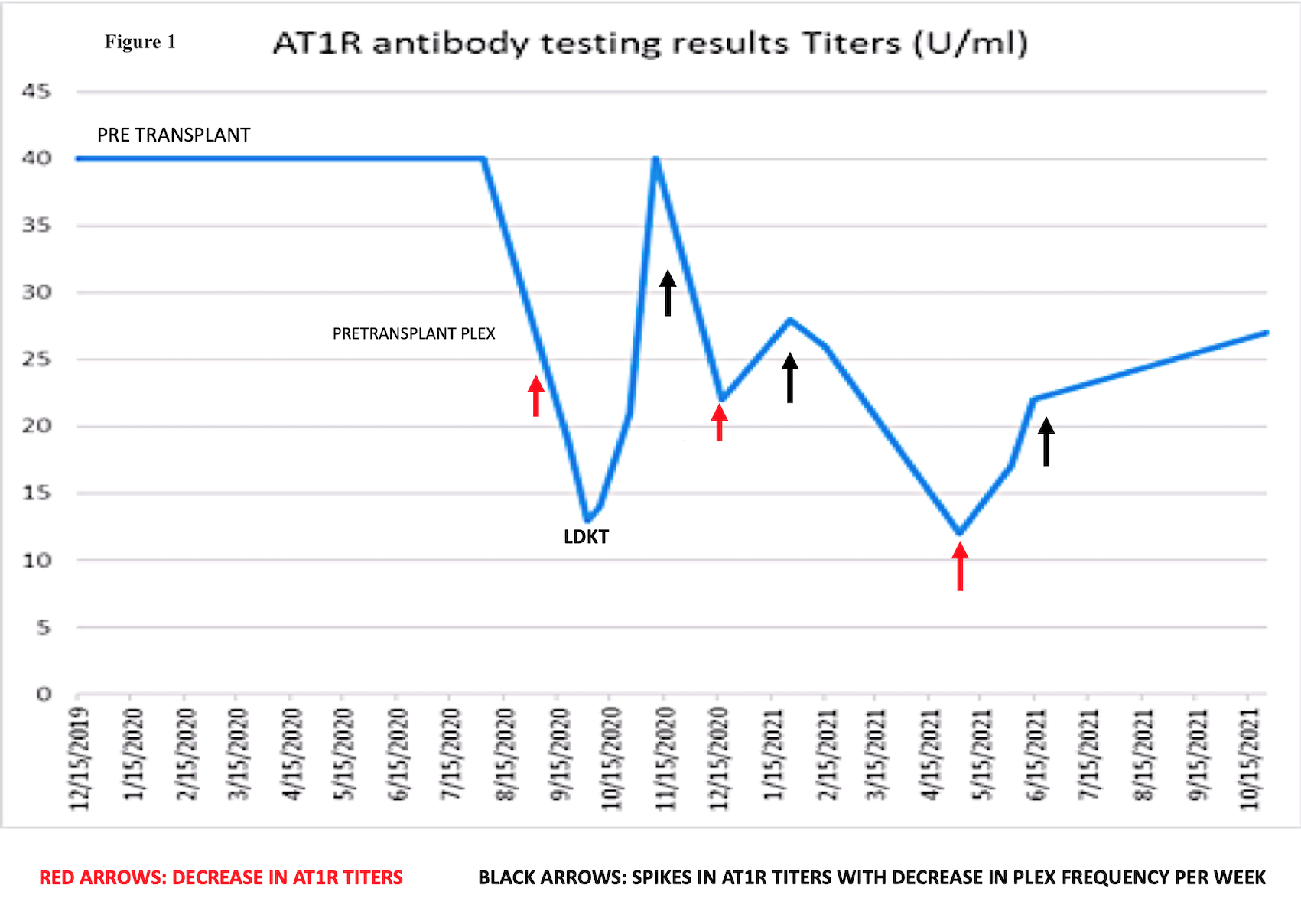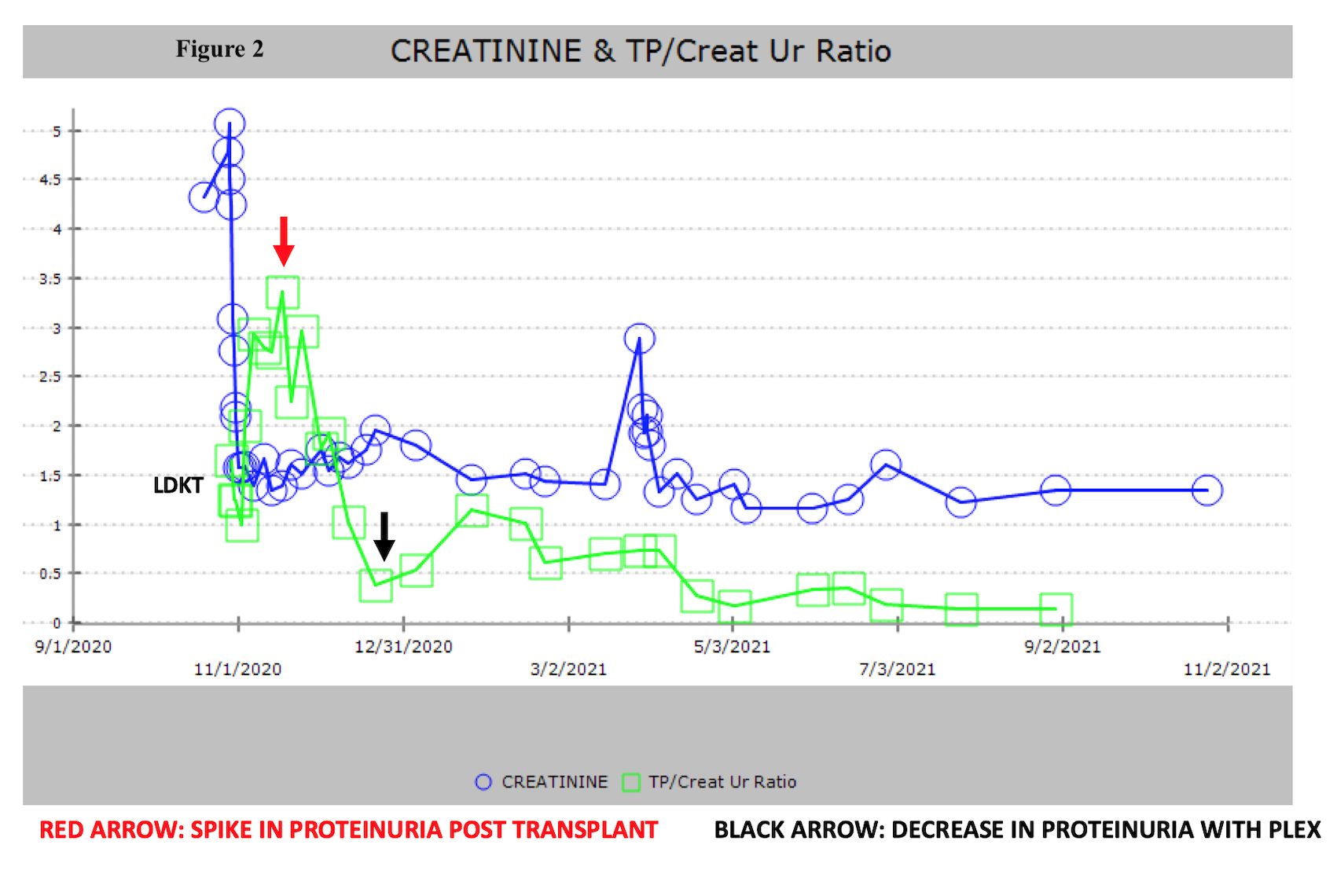Plasmapheresis Dependent AT1R Antibody Associated Recurrent FSGS After Living Donor Kidney Transplantation
Transplant Nephrology, Augusta University - Medical College of Georgia, Augusta, GA
Meeting: 2022 American Transplant Congress
Abstract number: 1417
Keywords: Glomerulonephritis, Kidney transplantation, Plasmapheresis, Recurrence
Topic: Clinical Science » Kidney » 49 - Recurrent Kidney Disease & Genetics
Session Information
Session Name: Recurrent Kidney Disease & Genetics
Session Type: Poster Abstract
Date: Monday, June 6, 2022
Session Time: 7:00pm-8:00pm
 Presentation Time: 7:00pm-8:00pm
Presentation Time: 7:00pm-8:00pm
Location: Hynes Halls C & D
*Purpose: Antibodies against Angiotensin II type 1 receptors (AT1R-Abs) may predispose to podocyte injury, glomerular endotheliosis and proteinuria. The management of AT1R-Ab associated recurrent FSGS after LRKT is presented and treatment nuances discussed.
*Methods: Chart review of a patient with recurrent FSGS after LRKT in the setting of high AT1R antibody titers who has remained plasmapheresis dependent post-transplant.
*Results: A 31 y/o male with ESRD secondary to FSGS, prior DDKT (failed due to acute cellular rejection) received a living related, HLA identical kidney transplant with thymoglobulin induction and standard triple immunosuppression. Pre-transplant AT1R-Ab titer was elevated at 40 U/ml. The patient had 18 plasmapheresis sessions and Rituximab planned 1 month pre-transplant was terminated early due to an infusion reaction. Nadir creatinine post-transplant was 1.3 mg/dl. Proteinuria peaking at 3.5 gm/day developed 1 month post-transplant. AT1R-Ab titer rose concomitantly to 40 U/ml. Biopsy showed 1/7 glomeruli with segmental sclerosis, EM with diffuse epithelial foot process effacement consistent with recurrent FSGS and no acute rejection. Plasmapheresis was started and losartan was titrated up to 100 mg daily. Proteinuria and AT1R-Ab titer decreased rapidly with plasmapheresis three times/week but spiked again to over 1 gram per day with decrease in frequency of treatments to bi-monthly (Figure 1 and 2). Creatinine settled at 1.5 mg/dl. He has remained plasmapheresis dependent once/week at 1 year post-transplant to keep the AT1R-Ab titer under control and proteinuria in remission.
*Conclusions: This case demonstrates the difficult scenario of treating AT1R-Ab associated recurrent FSGS. With maximal angiotensin receptor blockade and continued plasmapheresis, proteinuria decreased significantly and remained stable under 500 mg/day with stable allograft function. Though plasmapheresis was effective in removing AT1R-Abs, rebound in titers occurred with decreasing treatment frequency and plasmapheresis once a week has been required to maintain remission. Further investigation is needed regarding AT1R-Abs and recurrent FSGS particularly with regard to long term management and outcomes.
To cite this abstract in AMA style:
Mallavarapu RK. Plasmapheresis Dependent AT1R Antibody Associated Recurrent FSGS After Living Donor Kidney Transplantation [abstract]. Am J Transplant. 2022; 22 (suppl 3). https://atcmeetingabstracts.com/abstract/plasmapheresis-dependent-at1r-antibody-associated-recurrent-fsgs-after-living-donor-kidney-transplantation/. Accessed December 13, 2025.« Back to 2022 American Transplant Congress


